Experimental Investigation of Wave Propagation and Overtopping over Seawalls on a Reef Flat
Abstract
:1. Introduction
2. Experimental Set-Up
3. Results
3.1. Wave Propagation Process
3.1.1. Wave Propagation for the Reef Topography
3.1.2. Wave Propagation for the Vertical Seawall
3.1.3. Wave Propagation for the Sloped Seawall
3.2. Wave Pressure Distribution
3.2.1. Wave Pressure Distribution on the Vertical Seawall
3.2.2. Wave Pressure Distribution on the Sloped Seawall
3.3. Wave Overtopping
3.3.1. Wave Overtopping over the Vertical Seawall
3.3.2. Wave Overtopping over the Sloped Seawall
3.4. Prediction Formula
4. Discussion
5. Conclusions
Author Contributions
Funding
Institutional Review Board Statement
Informed Consent Statement
Data Availability Statement
Acknowledgments
Conflicts of Interest
References
- Tajima, Y. Case study on impact of storm waves on inundation characteristics. In Proceedings of the IUTAM Symposium on Storm Surge Modelling and Forecasting, Shanghai, China, 17–20 October 2016; pp. 36–43. [Google Scholar]
- Madin, J.S.; Connolly, S.R. Ecological consequences of major hydrodynamic disturbances on coral reefs. Nature 2006, 444, 477–480. [Google Scholar] [CrossRef]
- Baldock, T.E.; Shabani, B.; Callaghan, D.P.; Hu, Z.; Mumby, P.J. Two-dimensional modelling of wave dynamics and wave forces on fringing coral reefs. Coast. Eng. 2020, 155, 103594. [Google Scholar] [CrossRef]
- Yu, T.S.; Meng, X.Y.; Li, T.Y.; Guo, Q.Y.; Li, Y.C. Numerical simulation of interaction between wave-driven currents and revetment on coral reefs. Ocean Eng. 2022, 254, 20. [Google Scholar] [CrossRef]
- Nwogu, O.; Demirbilek, Z. Infragravity Wave Motions and Runup over Shallow Fringing Reefs. J. Waterw. Port Coast. Ocean Eng.-ASCE 2010, 136, 295–305. [Google Scholar] [CrossRef]
- Ma, G.F.; Su, S.F.; Liu, S.G.; Chu, J.C. Numerical simulation of infragravity waves in fringing reefs using a shock-capturing non-hydrostatic model. Ocean Eng. 2014, 85, 54–64. [Google Scholar] [CrossRef]
- Lowe, R.J.; Koseff, J.R.; Monismith, S.G. Oscillatory flow through submerged canopies: 1. Velocity structure. J. Geophys. Res.-Ocean. 2005, 110, 17. [Google Scholar] [CrossRef] [Green Version]
- Gelfenbaum, G.; Apotsos, A.; Stevens, A.W.; Jaffe, B. Effects of fringing reefs on tsunami inundation: American Samoa. Earth-Sci. Rev. 2011, 107, 12–22. [Google Scholar] [CrossRef]
- Ferrario, F.; Beck, M.W.; Storlazzi, C.D.; Micheli, F.; Shepard, C.C.; Airoldi, L. The effectiveness of coral reefs for coastal hazard risk reduction and adaptation. Nat. Commun. 2014, 5, 9. [Google Scholar] [CrossRef] [Green Version]
- Yao, Y.; He, F.; Tang, Z.J.; Liu, Z.S. A study of tsunami-like solitary wave transformation and run-up over fringing reefs. Ocean Eng. 2018, 149, 142–155. [Google Scholar] [CrossRef]
- Ning, Y.; Liu, W.; Sun, Z.; Zhao, X.; Zhang, Y. Parametric study of solitary wave propagation and runup over fringing reefs based on a Boussinesq wave model. J. Mar. Sci. Technol. 2019, 24, 512–525. [Google Scholar] [CrossRef]
- Zheng, J.H.; Yao, Y.; Chen, S.G.; Chen, S.B.; Zhang, Q.M. Laboratory study on wave-induced setup and wave-driven current in a 2DH reef-lagoon-channel system. Coast. Eng. 2020, 162, 13. [Google Scholar] [CrossRef]
- Fang, K.; Xiao, L.; Liu, Z.; Sun, J.; Dong, P.; Wu, H. Experiment and RANS modeling of solitary wave impact on a vertical wall mounted on a reef flat. Ocean Eng. 2022, 244, 110384. [Google Scholar] [CrossRef]
- Robertson, I.N.; Paczkowski, K.; Riggs, H.R.; Mohamed, A. Experimental Investigation of Tsunami Bore Forces on Vertical Walls. J. Offshore Mech. Arct. Eng. Trans. ASME 2013, 135, 8. [Google Scholar] [CrossRef]
- Yao, Y.; Du, R.; Yuan, W.; Jiang, C. Experimental study of wave transformation around the surf zone over fringing reefs. Acta Oceanol. Sin. 2015, 37, 66–73. [Google Scholar]
- Liu, Y.; Li, S.; Liao, Z.; Liu, K. Physical and numerical modeling of random wave transformation and overtopping on reef topography. Ocean Eng. 2021, 220, 108390. [Google Scholar] [CrossRef]
- Beetham, E.; Kench, P.S.; O’Callaghan, J.; Popinet, S. Wave transformation and shoreline water level on Funafuti Atoll, Tuvalu. J. Geophys. Res. Ocean. 2016, 121, 311–326. [Google Scholar] [CrossRef] [Green Version]
- Masselink, G.; Tuck, M.; McCall, R.; van Dongeren, A.; Ford, M.; Kench, P. Physical and Numerical Modeling of Infragravity Wave Generation and Transformation on Coral Reef Platforms. J. Geophys. Res. Ocean. 2019, 124, 1410–1433. [Google Scholar] [CrossRef]
- Yao, Y.; Chen, X.J.; Xu, C.H.; Jia, M.J.; Jiang, C.B. Modeling solitary wave transformation and run-up over fringing reefs with large bottom roughness. Ocean Eng. 2020, 218, 12. [Google Scholar] [CrossRef]
- Fu, R.L.; Ma, Y.X.; Dong, G.H. Investigation of wave-driven currents and statistical moments of irregular waves over a one dimensional horizontal fringing reef. Appl. Ocean Res. 2021, 112, 14. [Google Scholar] [CrossRef]
- Molines, J.; Herrera, M.P.; Gomez-Martin, M.E.; Medina, J.R. Distribution of individual wave overtopping volumes on mound breakwaters. Coast. Eng. 2019, 149, 15–27. [Google Scholar] [CrossRef]
- AlYousif, A.; AlKhaldi, M.S.; Al-Amer, F.; Neelamani, S. Wave action on a vertical wall with a submerged horizontal plate: Analysis of phase variation of forces and probability of exceedance. Int. J. Nav. Archit. Ocean Eng. 2022, 14, 14. [Google Scholar] [CrossRef]
- Mares-Nasarre, P.; Molines, J.; Gomez-Martin, M.E.; Medina, J.R. Individual wave overtopping volumes on mound breakwaters in breaking wave conditions and gentle sea bottoms. Coast. Eng. 2020, 159, 12. [Google Scholar] [CrossRef]
- Koosheh, A.; Etemad-Shahidi, A.; Cartwright, N.; Tomlinson, R.; Van Gent, M.R.A. Experimental study of wave overtopping at rubble mound seawalls. Coast. Eng. 2022, 172, 11. [Google Scholar] [CrossRef]
- Chen, S.; Yao, Y.; Guo, H.; Jia, M. Numerical investigation of monochromatic wave interaction with a vertical seawall located on a reef flat. Ocean Eng. 2020, 214, 107847. [Google Scholar] [CrossRef]
- Liu, Y.; Li, S.; Chen, S.; Hu, C.; Fan, Z.; Jin, R. Random wave overtopping of vertical seawalls on coral reefs. Appl. Ocean Res. 2020, 100, 102166. [Google Scholar] [CrossRef]
- Cao, D.P.; Yuan, J.; Chen, H.; Zhao, K.F.; Liu, P.L.F. Wave overtopping flow striking a human body on the crest of an impermeable sloped seawall. Part I: Physical modeling. Coast. Eng. 2021, 167, 17. [Google Scholar] [CrossRef]
- Wen, H.; Ren, B.; Zhang, X.; Yu, X. SPH Modeling of Wave Transformation over a Coral Reef with Seawall. J. Waterw. Port Coast. Ocean Eng. 2019, 145, 04018026. [Google Scholar] [CrossRef]
- Yao, Y.; Huang, Z.; Monismith, S.G.; Lo, E.Y.M. 1DH Boussinesq modeling of wave transformation over fringing reefs. Ocean Eng. 2012, 47, 30–42. [Google Scholar] [CrossRef]

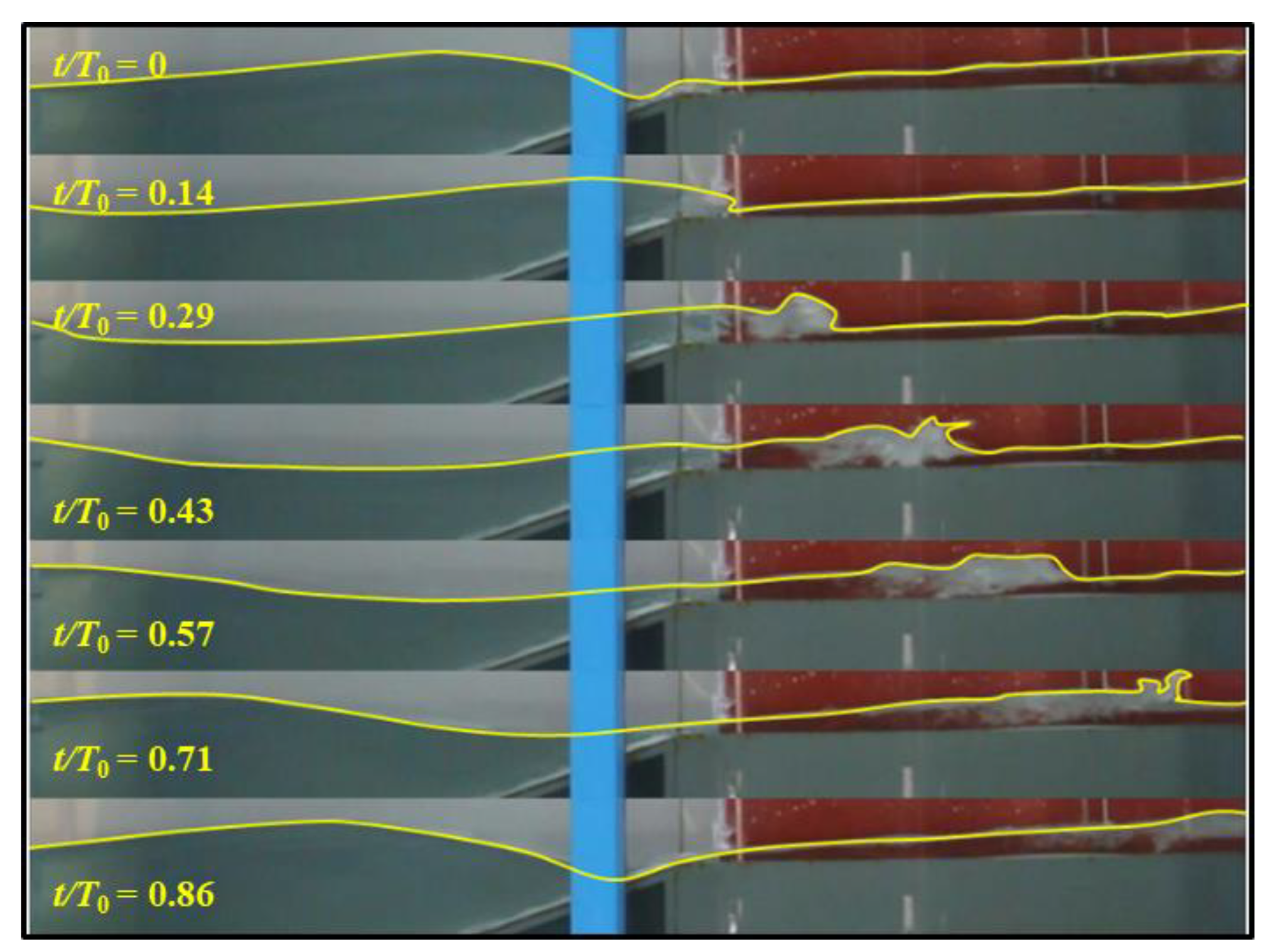
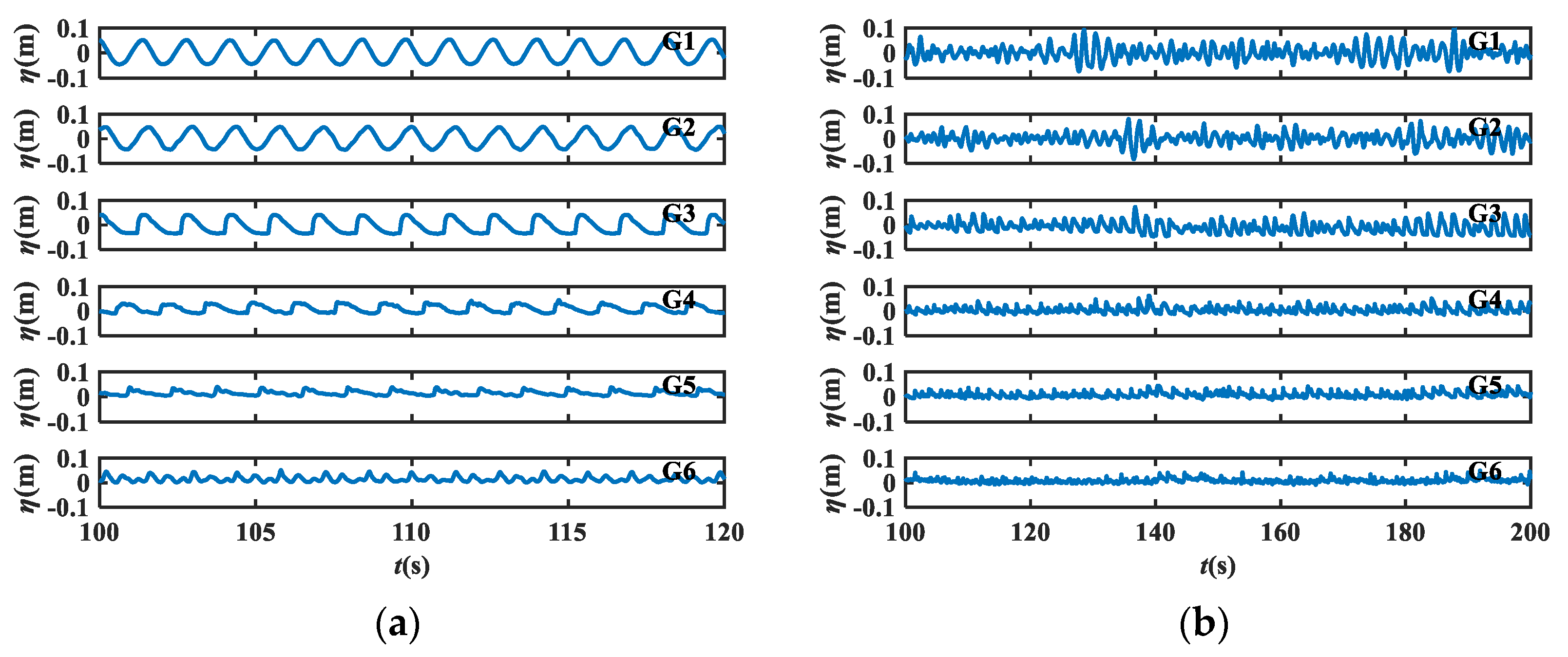

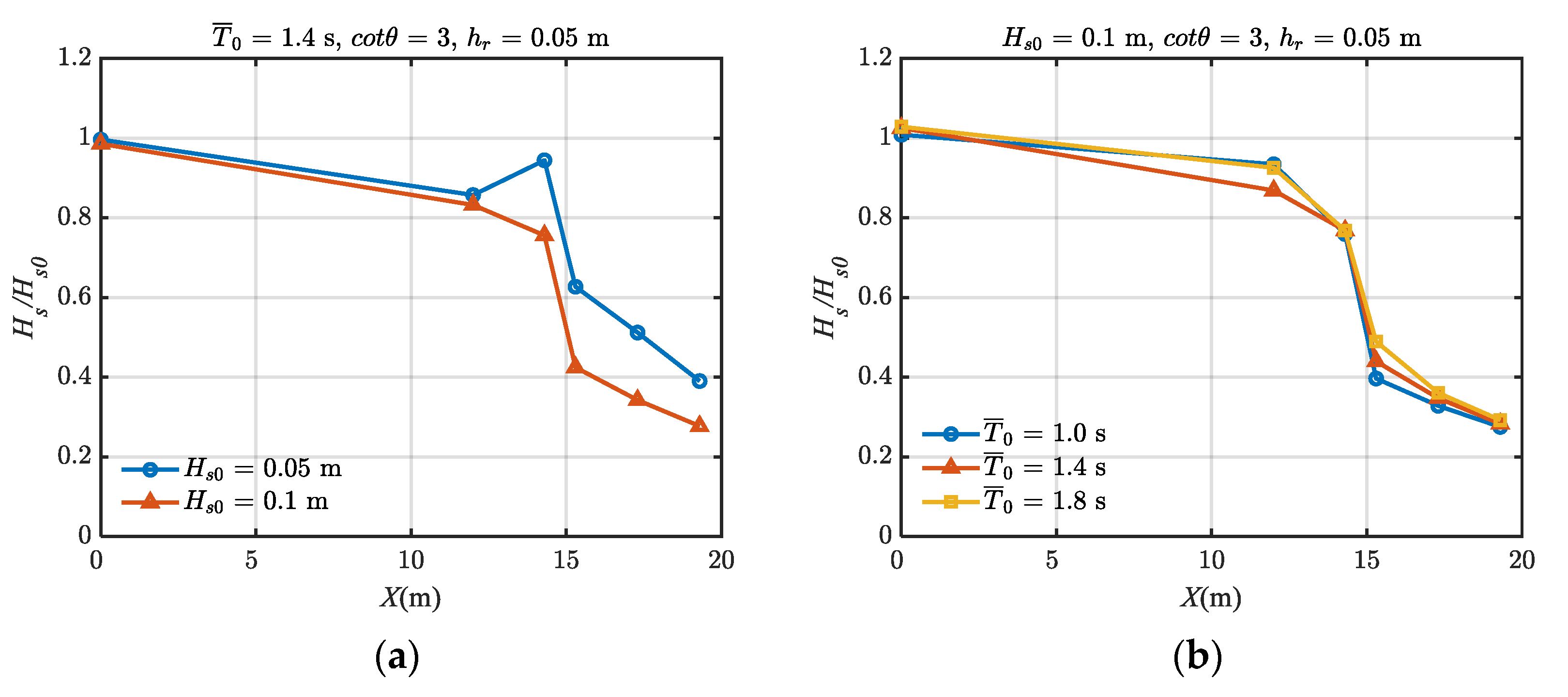


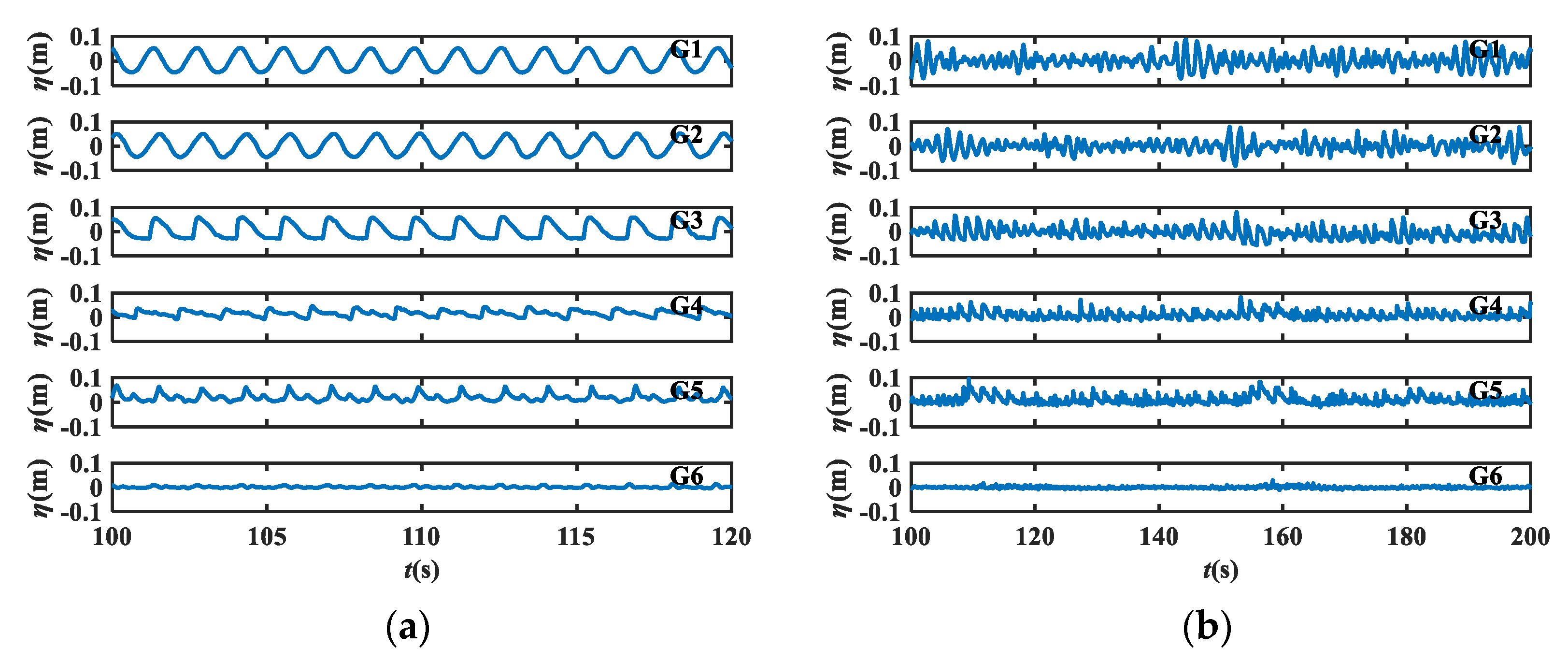
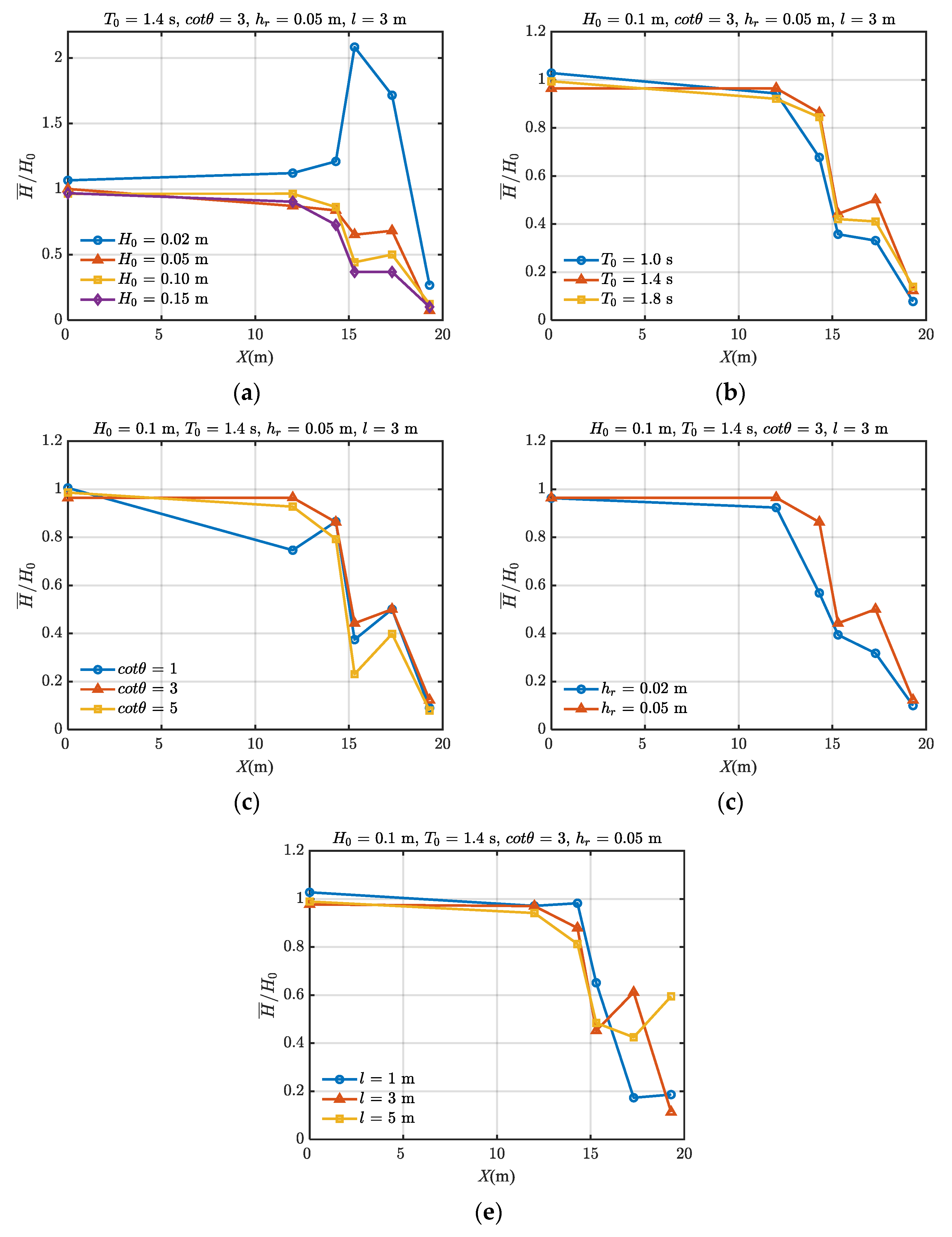



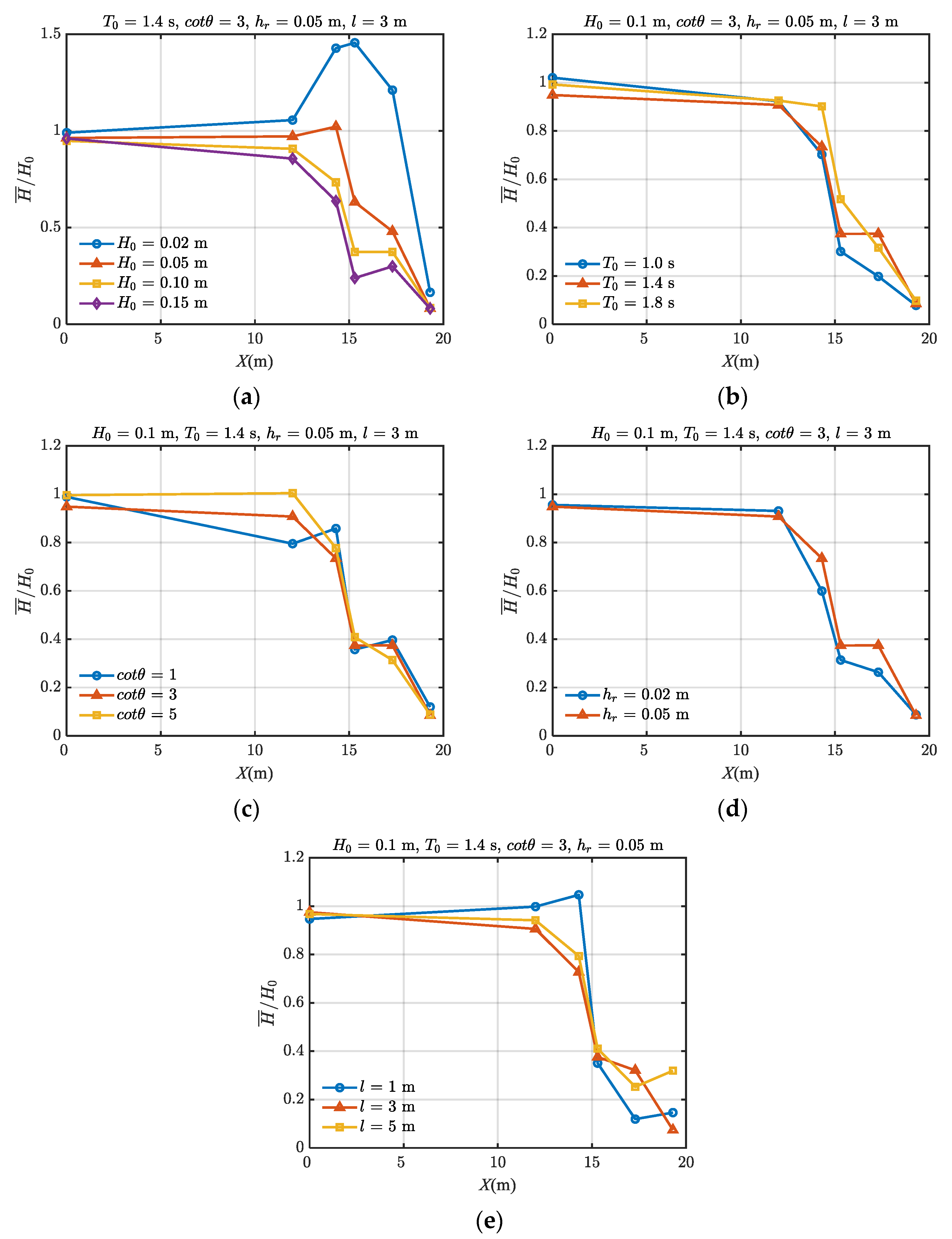
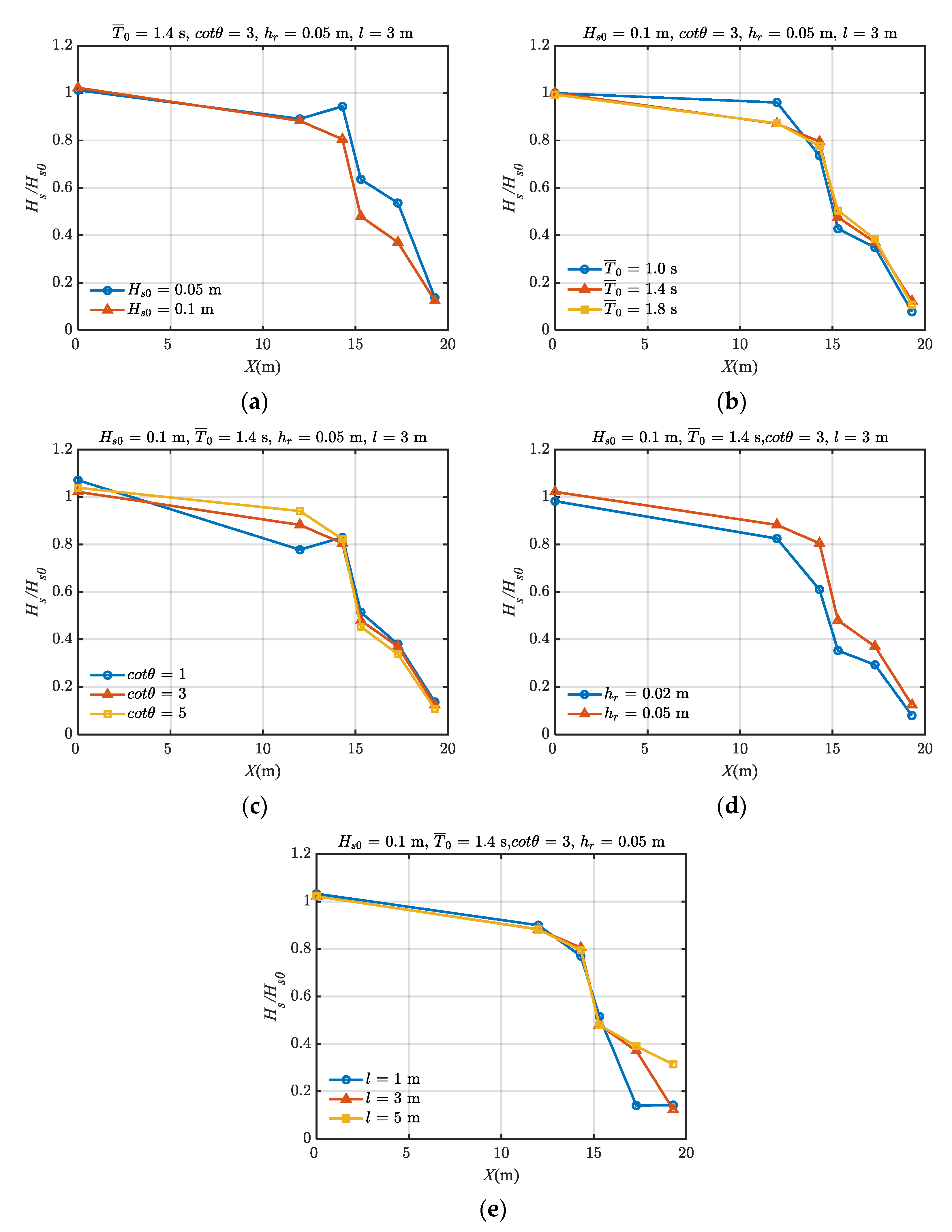
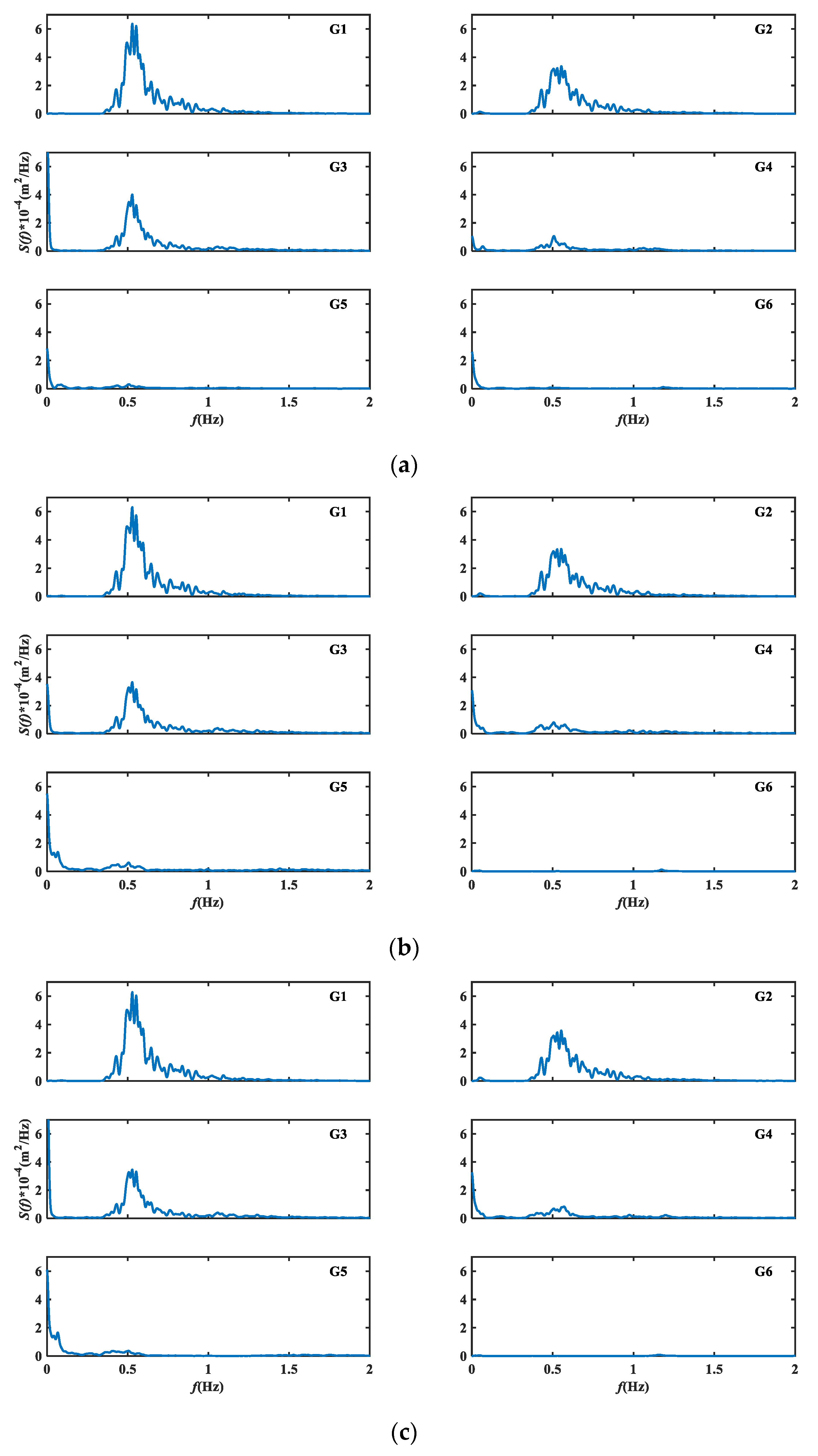
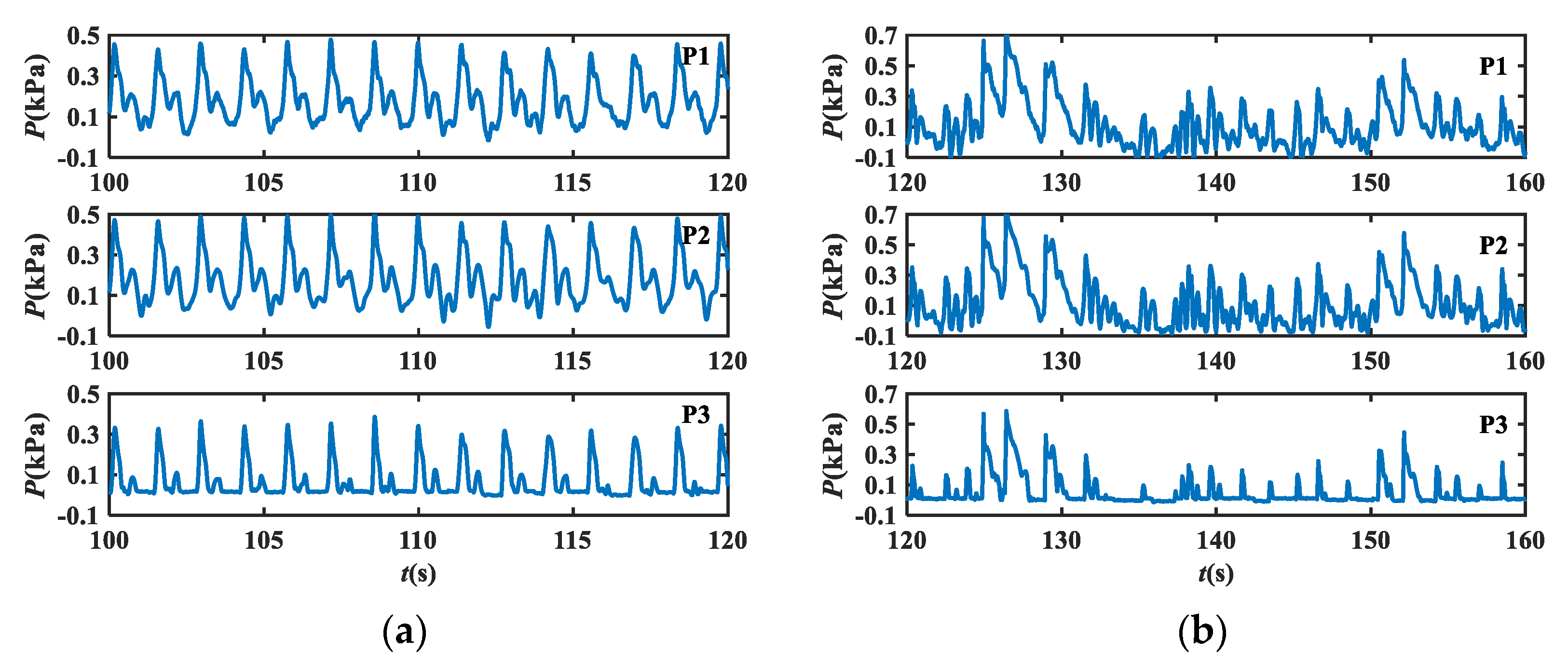
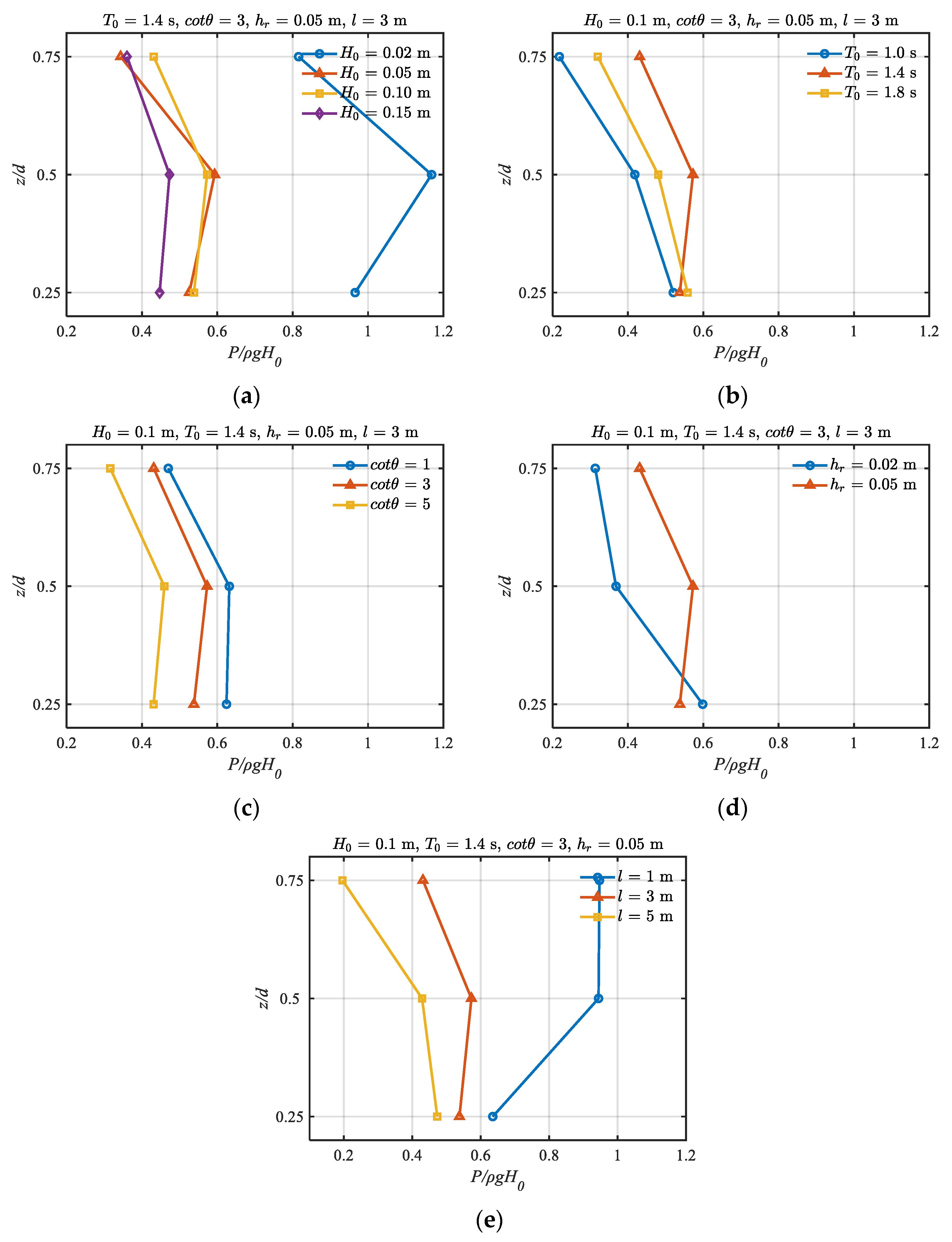

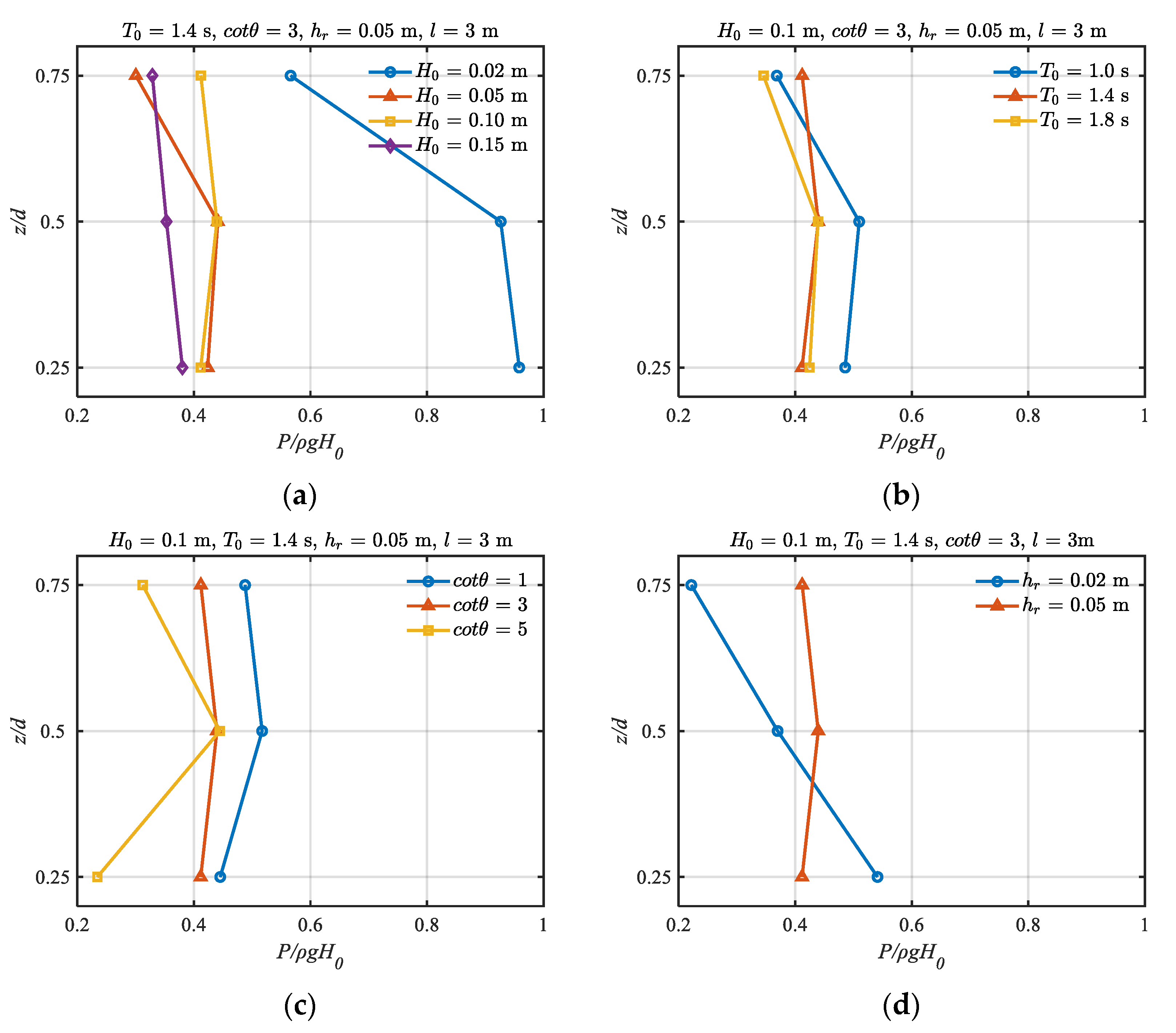
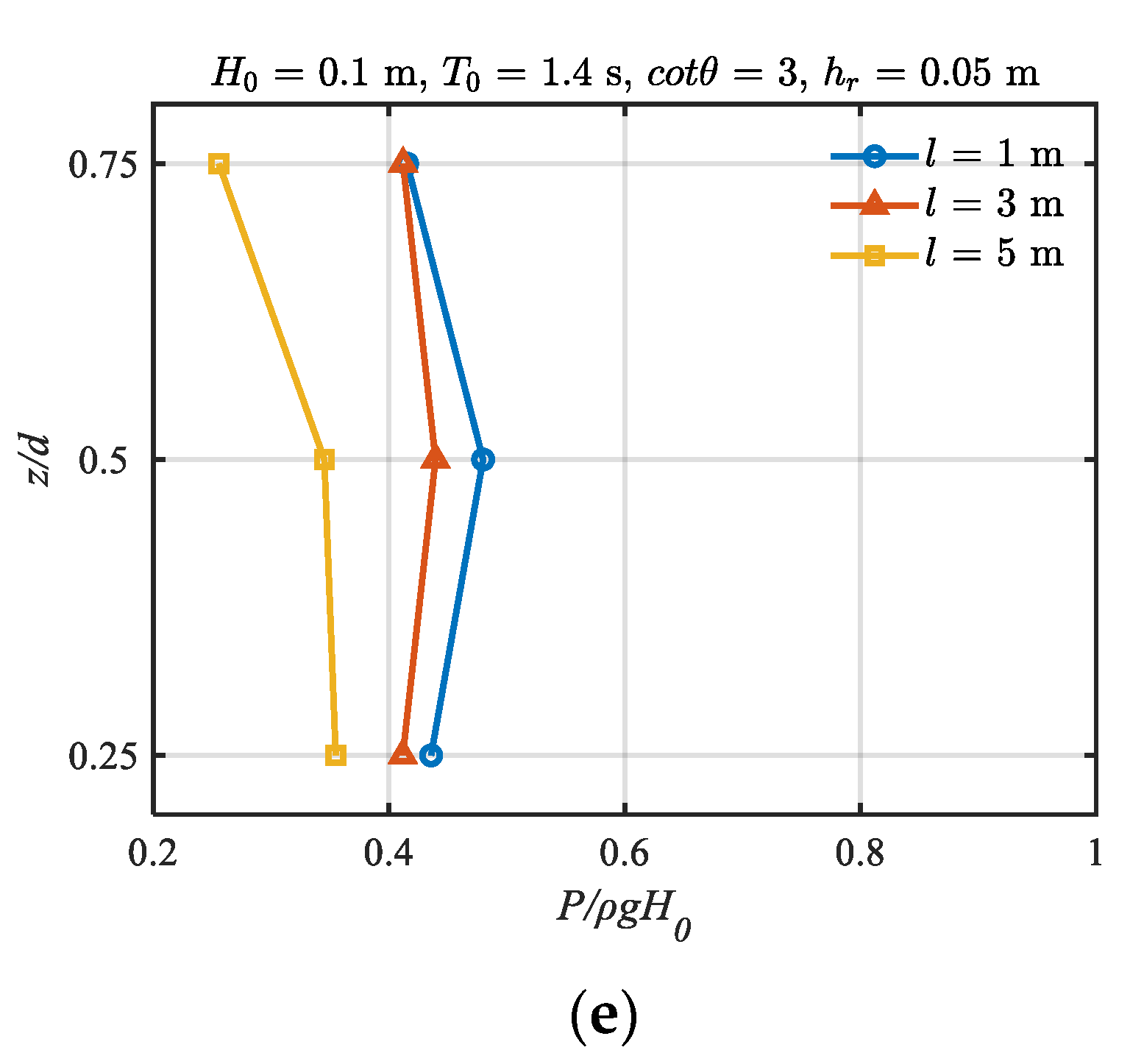
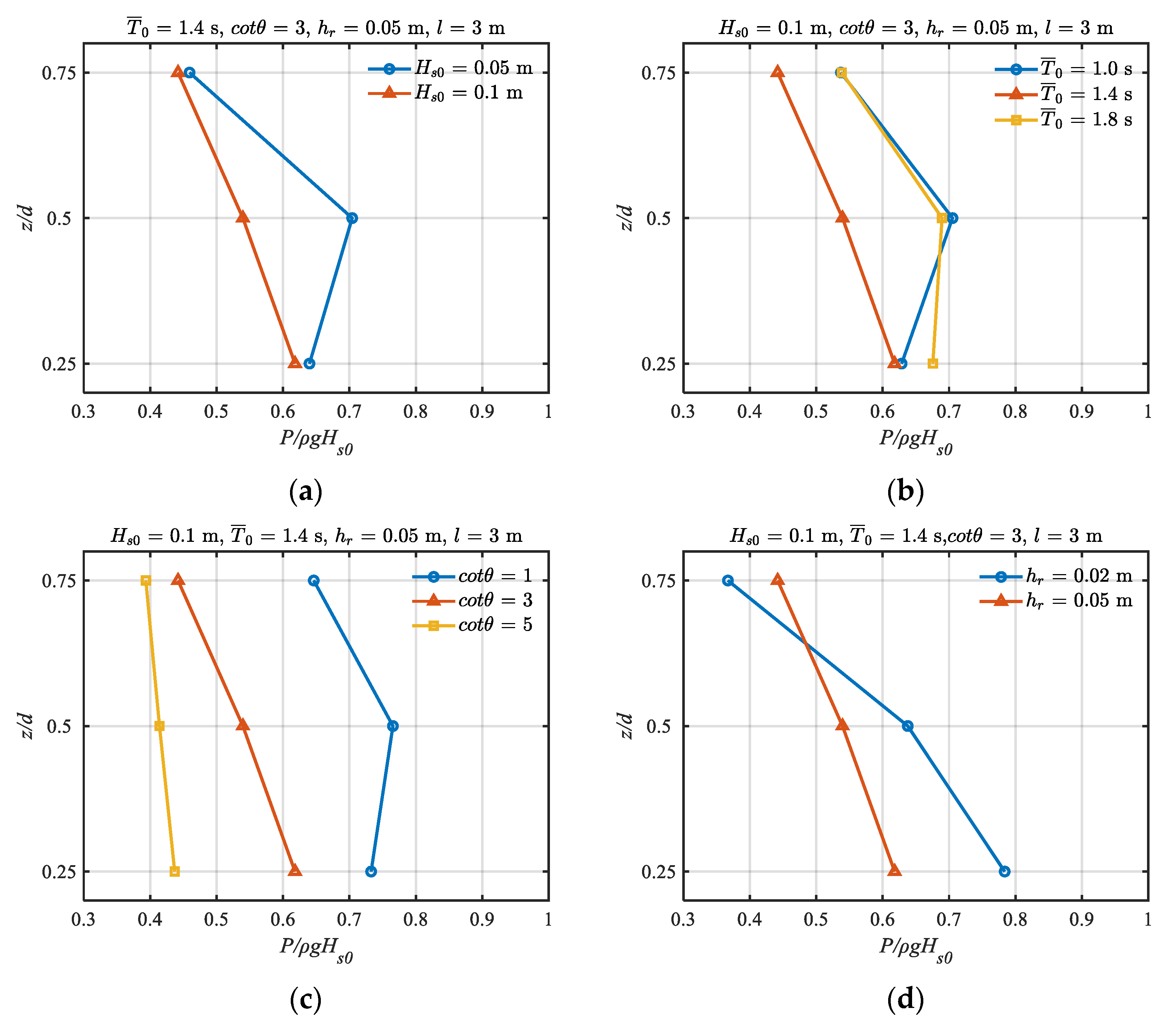
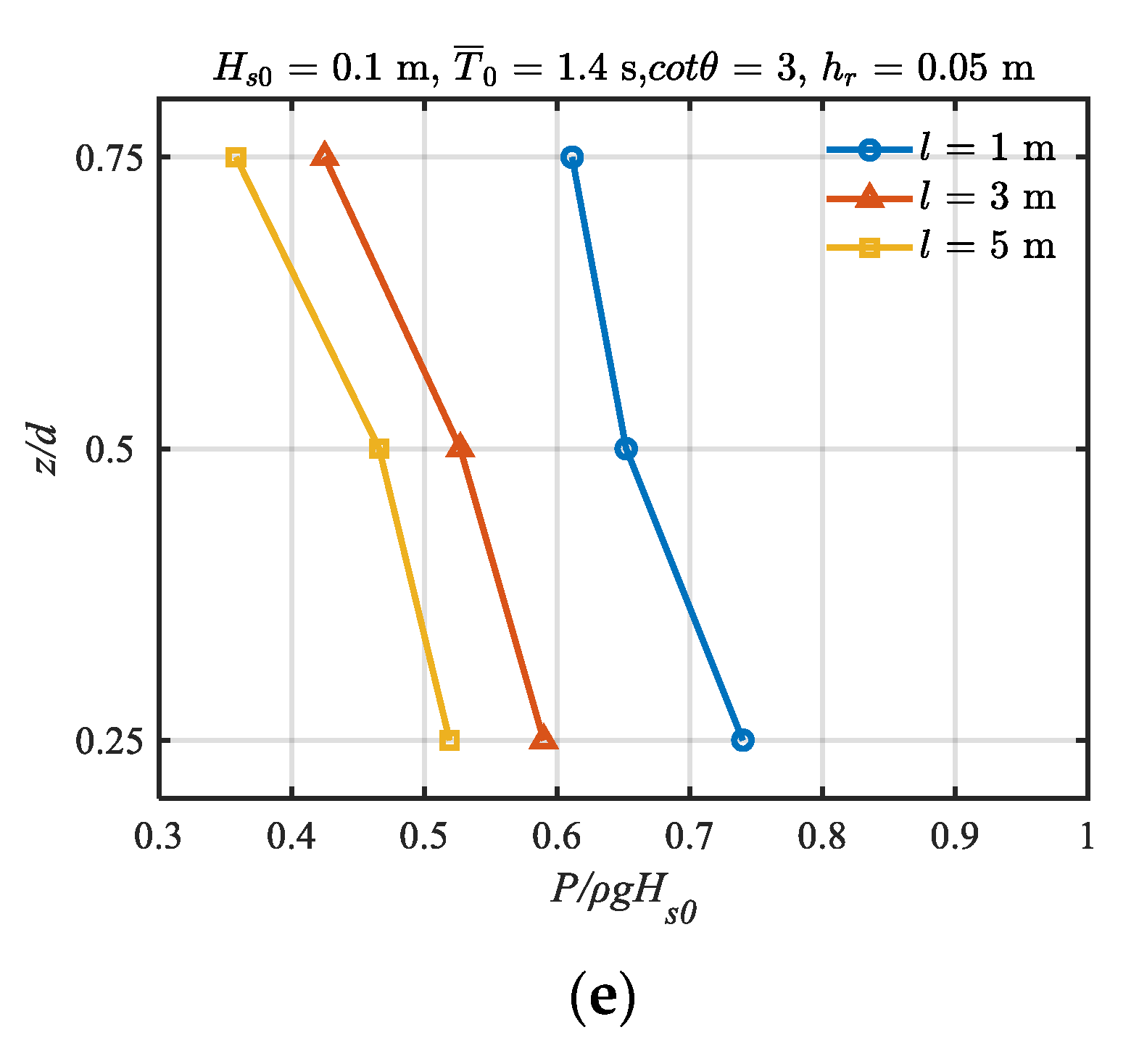


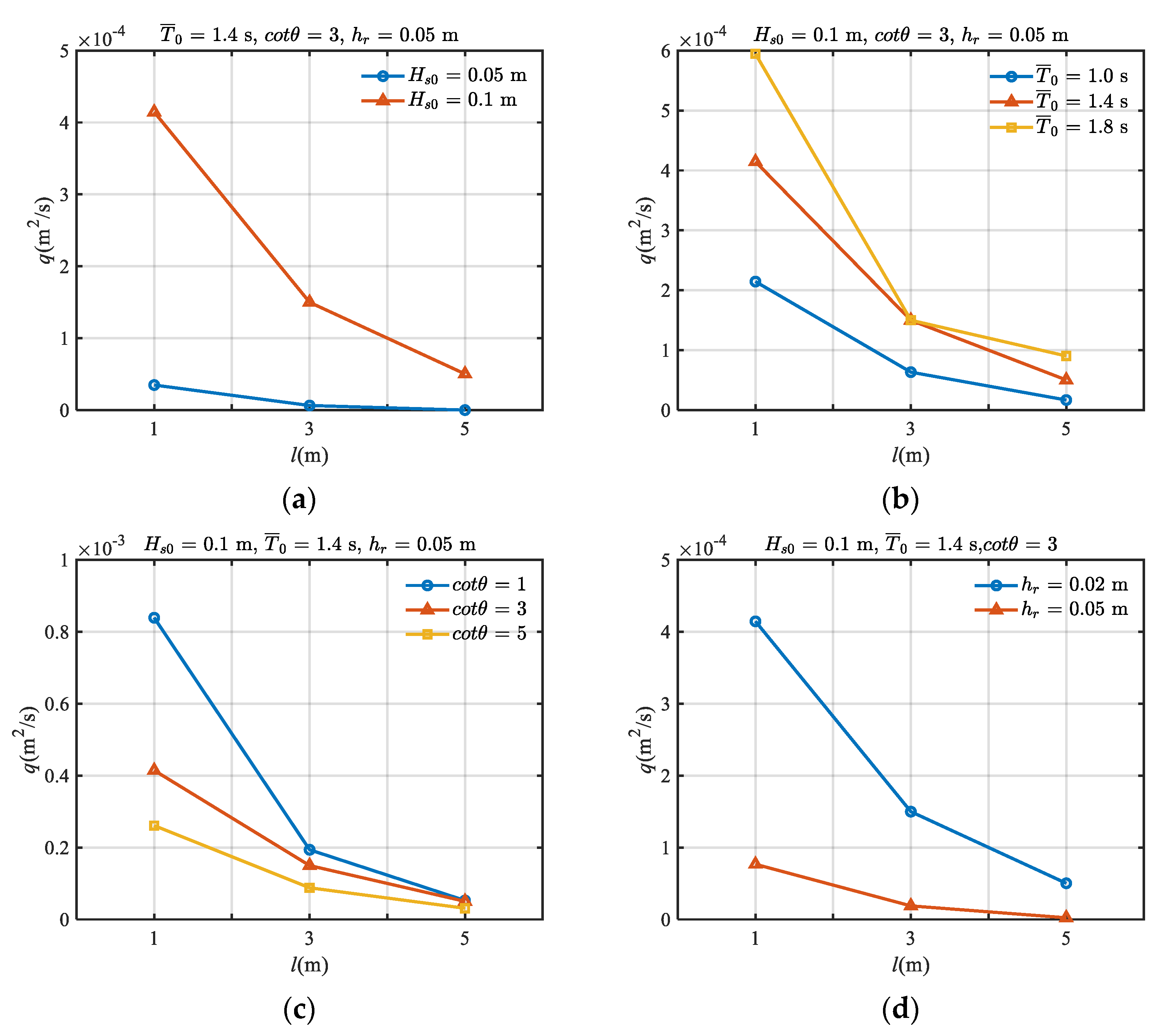
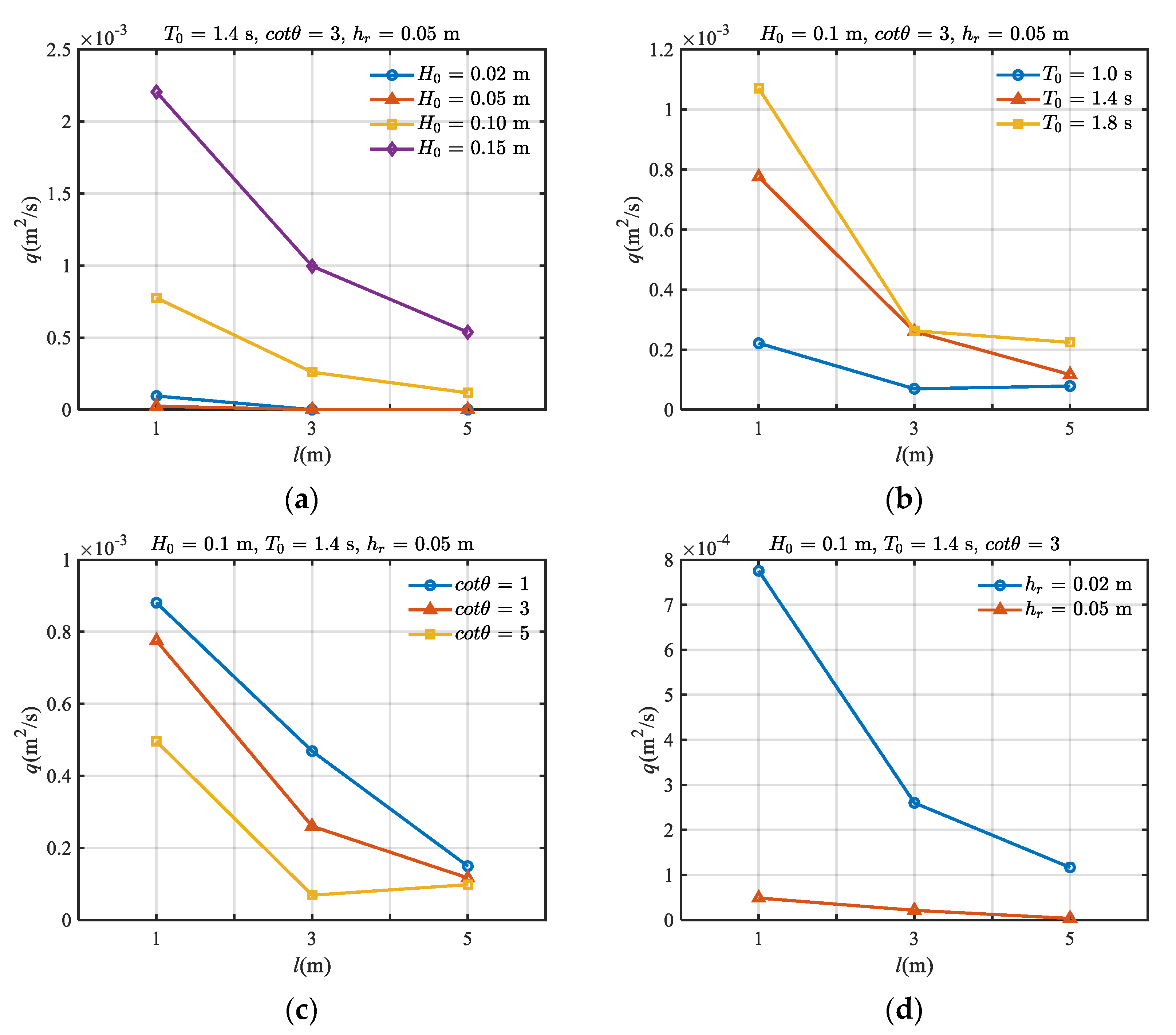
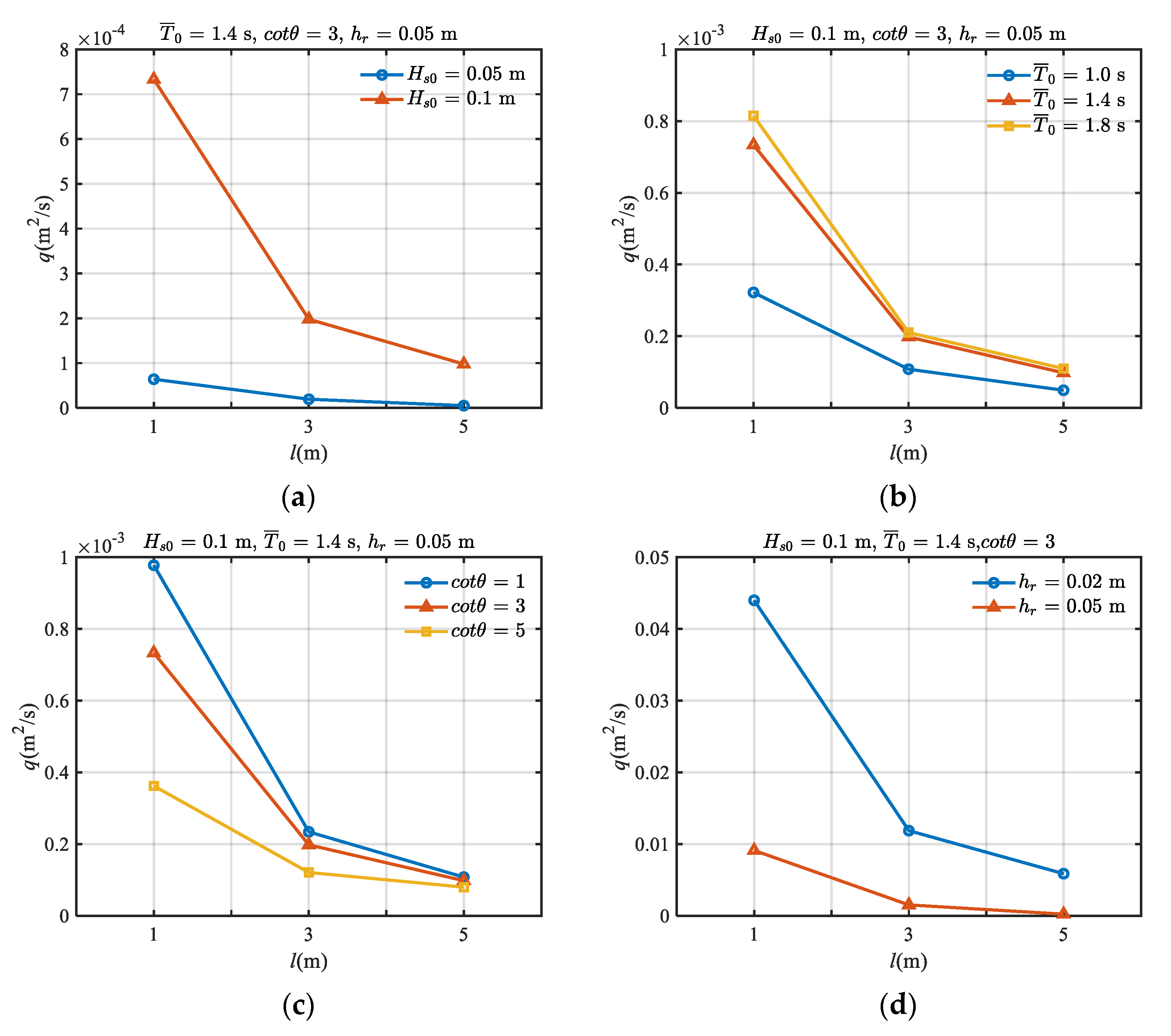
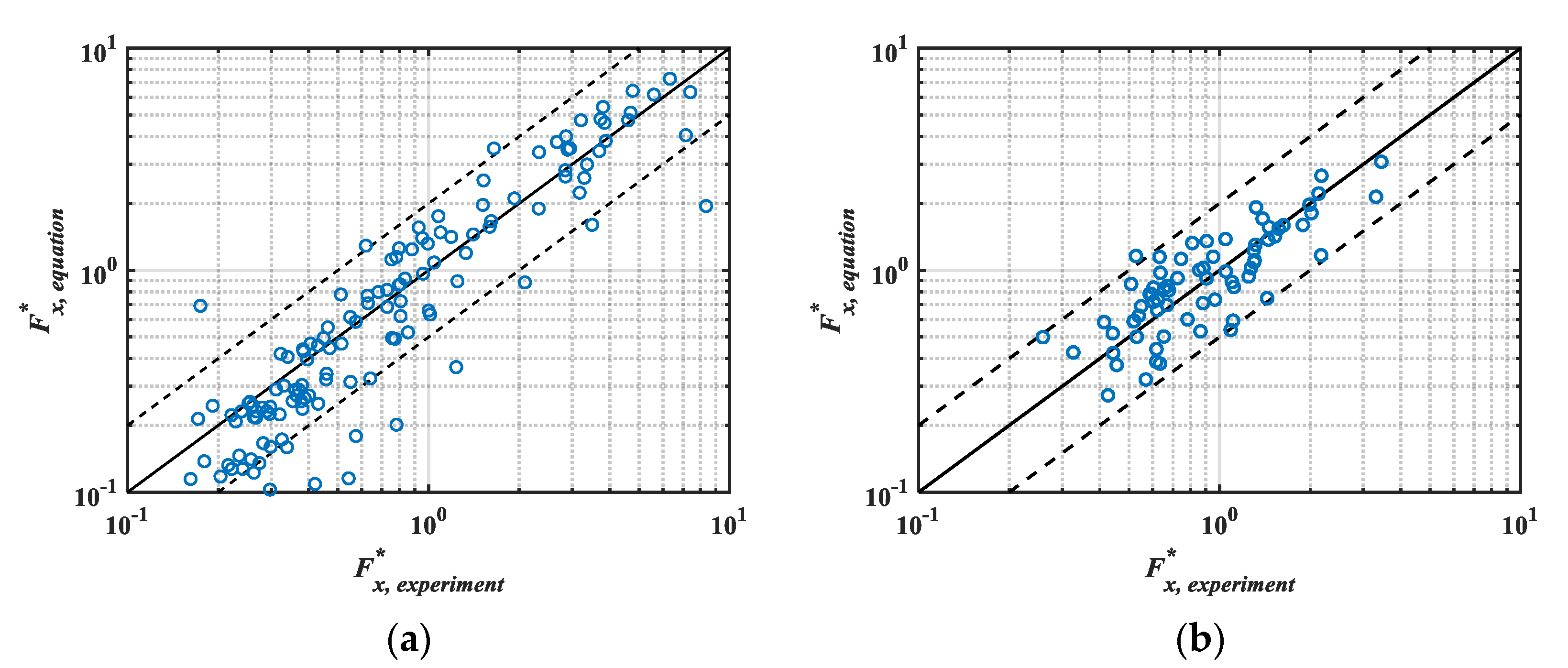
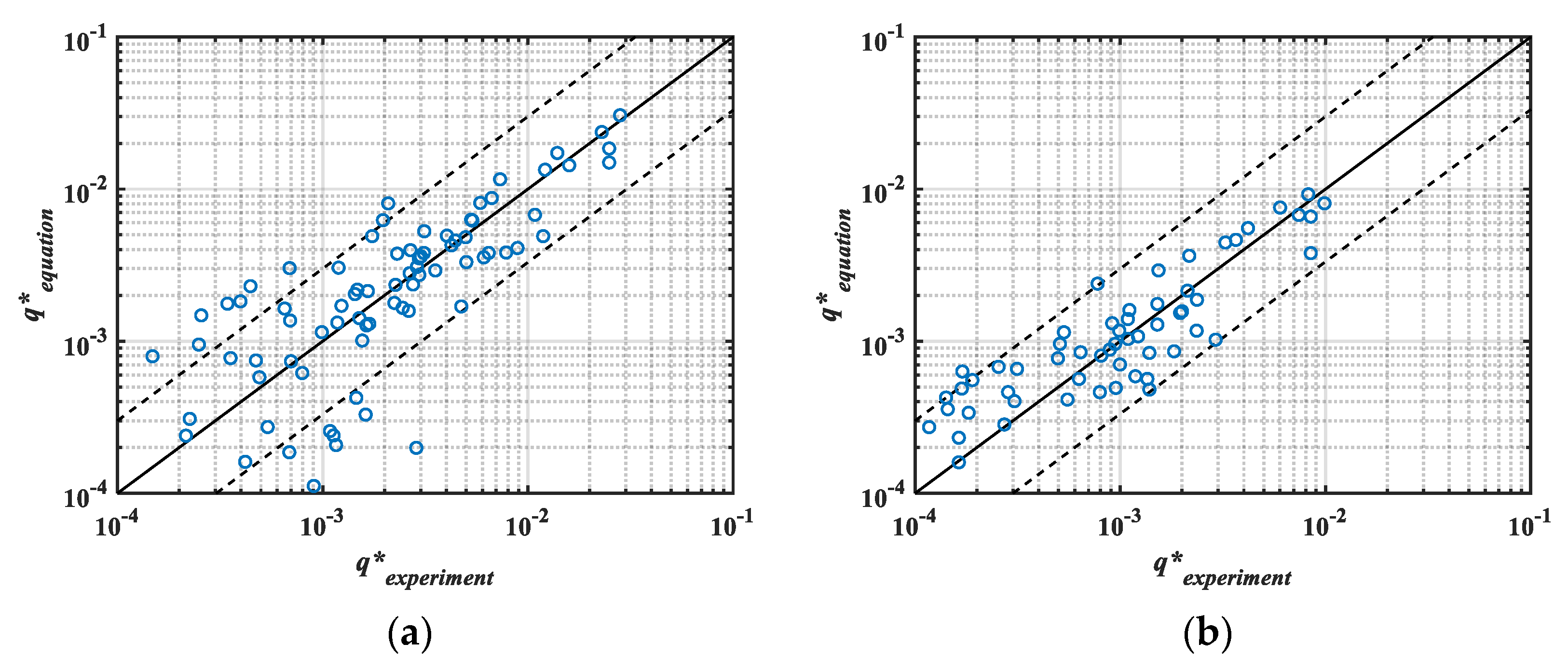
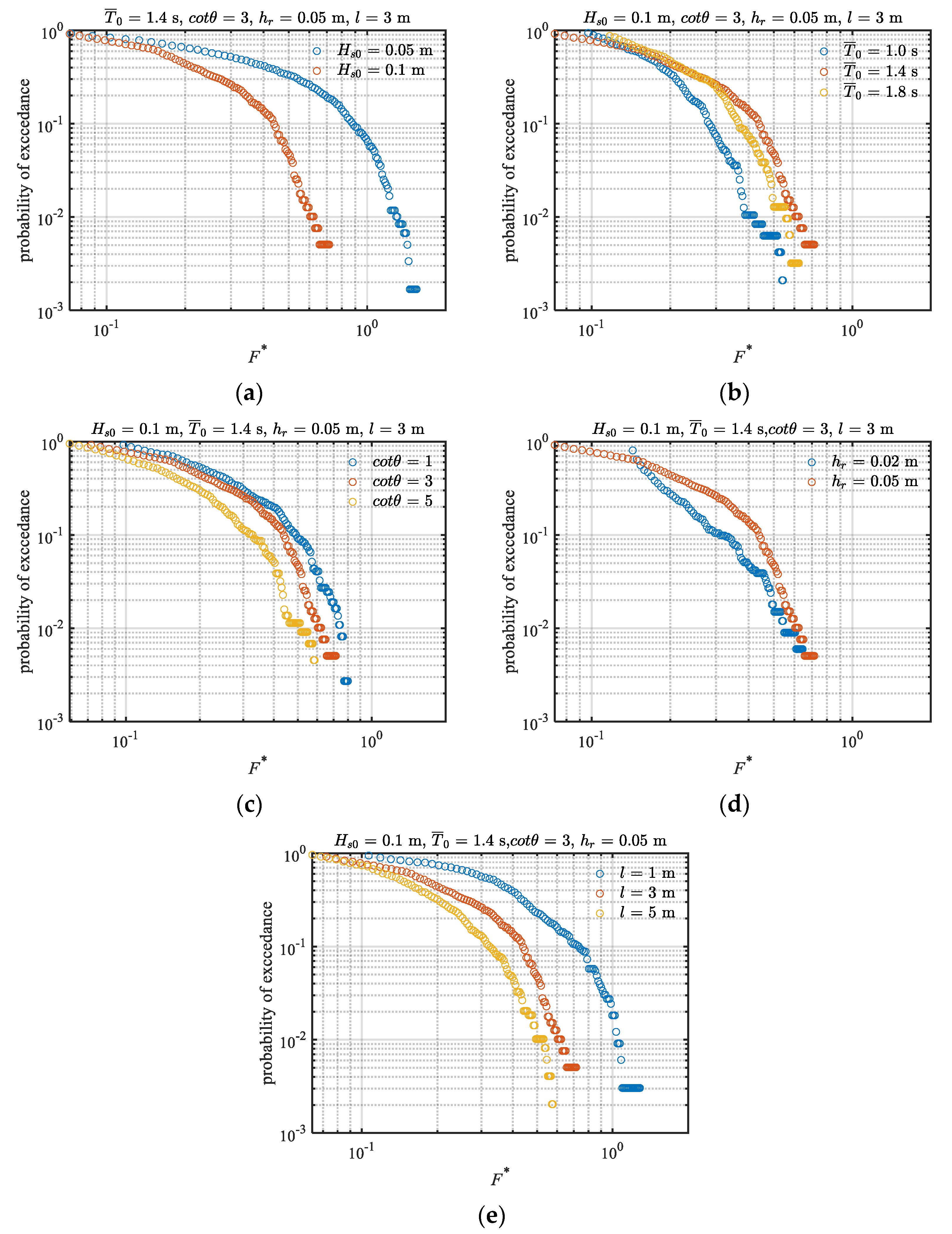
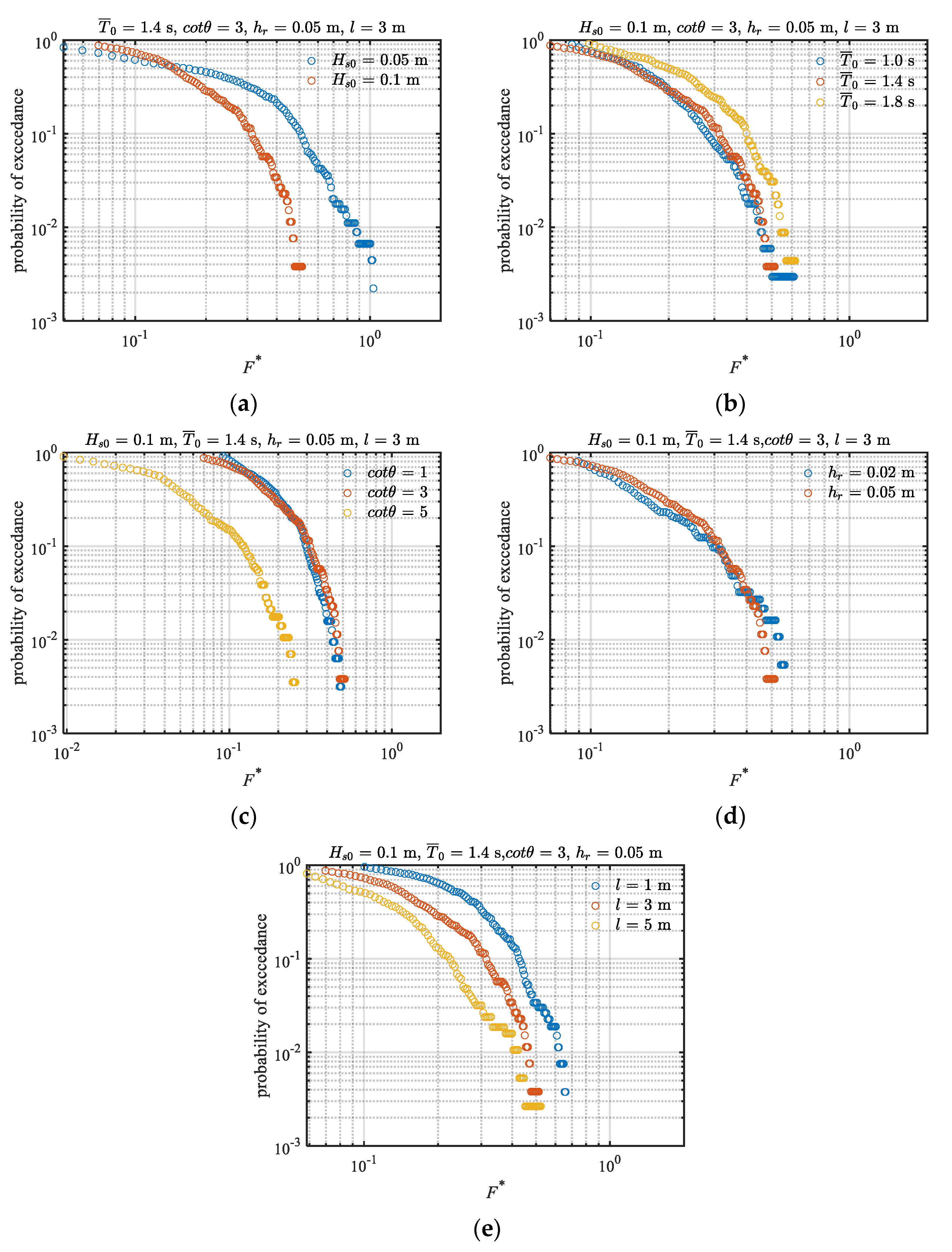
| No. | cotθ | T0 (s) | hr (m) | H0 (m) | Seawall | l (m) |
|---|---|---|---|---|---|---|
| 1 | 1 | 1.4 | 0.05 | 0.02, 0.05, 0.1, 0.15 | / | / |
| 2 | 3 | 1.4 | 0.05 | 0.02, 0.05, 0.1, 0.15 | / | / |
| 3 | 5 | 1.4 | 0.05 | 0.02, 0.05, 0.1, 0.15 | / | / |
| 4 | 3 | 1.0 | 0.05 | 0.02, 0.05, 0.1, 0.15 | / | / |
| 5 | 3 | 1.8 | 0.05 | 0.02, 0.05, 0.1, 0.15 | / | / |
| 6 | 3 | 1.4 | 0.02 | 0.02, 0.05, 0.1, 0.15 | / | / |
| 7 | 1 | 1.4 | 0.05 | 0.02, 0.05, 0.1, 0.15 | vertical seawall | 1, 3, 5 |
| 8 | 1 | 1.4 | 0.05 | 0.02, 0.05, 0.1, 0.15 | sloped seawall | 1, 3, 5 |
| 9 | 3 | 1.4 | 0.05 | 0.02, 0.05, 0.1, 0.15 | vertical seawall | 1, 3, 5 |
| 10 | 3 | 1.4 | 0.05 | 0.02, 0.05, 0.1, 0.15 | sloped seawall | 1, 3, 5 |
| 11 | 5 | 1.4 | 0.05 | 0.02, 0.05, 0.1, 0.15 | vertical seawall | 1, 3, 5 |
| 12 | 5 | 1.4 | 0.05 | 0.02, 0.05, 0.1, 0.15 | sloped seawall | 1, 3, 5 |
| 13 | 3 | 1.0 | 0.05 | 0.02, 0.05, 0.1, 0.15 | vertical seawall | 1, 3, 5 |
| 14 | 3 | 1.0 | 0.05 | 0.02, 0.05, 0.1, 0.15 | sloped seawall | 1, 3, 5 |
| 15 | 3 | 1.8 | 0.05 | 0.02, 0.05, 0.1, 0.15 | vertical seawall | 1, 3, 5 |
| 16 | 3 | 1.8 | 0.05 | 0.02, 0.05, 0.1, 0.15 | sloped seawall | 1, 3, 5 |
| 17 | 3 | 1.4 | 0.02 | 0.02, 0.05, 0.1, 0.15 | vertical seawall | 1, 3, 5 |
| 18 | 3 | 1.4 | 0.02 | 0.02, 0.05, 0.1, 0.15 | sloped seawall | 1, 3, 5 |
| No. | cotθ | hr (m) | Hs0 (m) | Seawall | l (m) | |
|---|---|---|---|---|---|---|
| 1 | 1 | 1.4 | 0.05 | 0.05, 0.1 | / | / |
| 2 | 3 | 1.4 | 0.05 | 0.05, 0.1 | / | / |
| 3 | 5 | 1.4 | 0.05 | 0.05, 0.1 | / | / |
| 4 | 3 | 1.0 | 0.05 | 0.05, 0.1 | / | / |
| 5 | 3 | 1.8 | 0.05 | 0.05, 0.1 | / | / |
| 6 | 3 | 1.4 | 0.02 | 0.05, 0.1 | / | / |
| 7 | 1 | 1.4 | 0.05 | 0.05, 0.1 | vertical seawall | 1, 3, 5 |
| 8 | 1 | 1.4 | 0.05 | 0.05, 0.1 | sloped seawall | 1, 3, 5 |
| 9 | 3 | 1.4 | 0.05 | 0.05, 0.1 | vertical seawall | 1, 3, 5 |
| 10 | 3 | 1.4 | 0.05 | 0.05, 0.1 | sloped seawall | 1, 3, 5 |
| 11 | 5 | 1.4 | 0.05 | 0.05, 0.1 | vertical seawall | 1, 3, 5 |
| 12 | 5 | 1.4 | 0.05 | 0.05, 0.1 | sloped seawall | 1, 3, 5 |
| 13 | 3 | 1.0 | 0.05 | 0.05, 0.1 | vertical seawall | 1, 3, 5 |
| 14 | 3 | 1.0 | 0.05 | 0.05, 0.1 | sloped seawall | 1, 3, 5 |
| 15 | 3 | 1.8 | 0.05 | 0.05, 0.1 | vertical seawall | 1, 3, 5 |
| 16 | 3 | 1.8 | 0.05 | 0.05, 0.1 | sloped seawall | 1, 3, 5 |
| 17 | 3 | 1.4 | 0.02 | 0.05, 0.1 | vertical seawall | 1, 3, 5 |
| 18 | 3 | 1.4 | 0.02 | 0.05, 0.1 | sloped seawall | 1, 3, 5 |
| No. | a1 | b1 | c1 | d1 | e1 | f1 |
|---|---|---|---|---|---|---|
| Regular wave | 1.04 | 1.59 | −0.12 | 0.0029 | −0.21 | 0.74 |
| Irregular wave | 0.30 | 0.70 | −0.43 | −0.0088 | −0.36 | 0.58 |
| No. | a2 | b2 | c2 | d2 | e2 | f2 |
|---|---|---|---|---|---|---|
| Regular wave | 0.0059 | −6.8 | 13.21 | −1.1 | 0.13 | 0.35 |
| Irregular wave | 0.0039 | −2.8 | 21.9 | −0.62 | 0.34 | −0.25 |
| Empirical Formula | Modification and Contribution |
|---|---|
| Considered the effect of relative distance l. Considered the effect of the slope angle of the seawall. Applied for both regular and irregular waves. | |
| Considered the effect of relative distance l. Considered the effect of the slope angle of the seawall. Applied for both regular and irregular waves. |
Disclaimer/Publisher’s Note: The statements, opinions and data contained in all publications are solely those of the individual author(s) and contributor(s) and not of MDPI and/or the editor(s). MDPI and/or the editor(s) disclaim responsibility for any injury to people or property resulting from any ideas, methods, instructions or products referred to in the content. |
© 2023 by the authors. Licensee MDPI, Basel, Switzerland. This article is an open access article distributed under the terms and conditions of the Creative Commons Attribution (CC BY) license (https://creativecommons.org/licenses/by/4.0/).
Share and Cite
Gao, Y.; Ren, L.; Wang, L. Experimental Investigation of Wave Propagation and Overtopping over Seawalls on a Reef Flat. J. Mar. Sci. Eng. 2023, 11, 836. https://doi.org/10.3390/jmse11040836
Gao Y, Ren L, Wang L. Experimental Investigation of Wave Propagation and Overtopping over Seawalls on a Reef Flat. Journal of Marine Science and Engineering. 2023; 11(4):836. https://doi.org/10.3390/jmse11040836
Chicago/Turabian StyleGao, Yangyang, Linguang Ren, and Lizhong Wang. 2023. "Experimental Investigation of Wave Propagation and Overtopping over Seawalls on a Reef Flat" Journal of Marine Science and Engineering 11, no. 4: 836. https://doi.org/10.3390/jmse11040836






